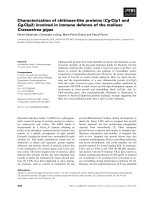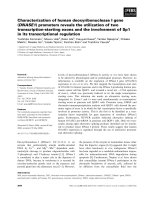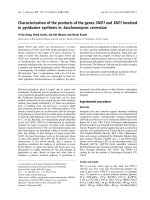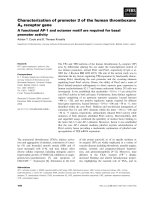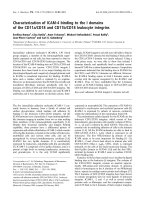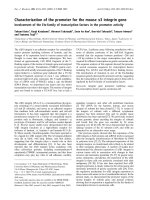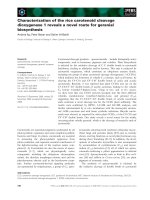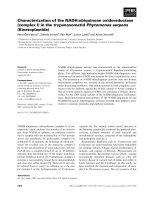Báo cáo khoa học: Characterization of the rice carotenoid cleavage dioxygenase 1 reveals a novel route for geranial biosynthesis ppt
Bạn đang xem bản rút gọn của tài liệu. Xem và tải ngay bản đầy đủ của tài liệu tại đây (1.03 MB, 12 trang )
Characterization of the rice carotenoid cleavage
dioxygenase 1 reveals a novel route for geranial
biosynthesis
Andrea Ilg, Peter Beyer and Salim Al-Babili
Faculty of Biology, Institute of Biology II, Albert-Ludwigs University of Freiburg, Germany
Carotenoids are isoprenoid pigments synthesized by all
photosynthetic organisms and some nonphotosynthetic
bacteria and fungi. In plants, carotenoids are essential
in protecting the photosynthetic apparatus from
photo-oxidation, and represent essential constituents of
the light-harvesting and of the reaction center com-
plexes [1–4]. Carotenoids are also the source of apoca-
rotenoids [5–7], which are physiologically active
compounds, including the ubiquitous chromophore
retinal, the chordate morphogen retinoic acid and the
phytohormone abscisic acid as the best-known exam-
ples. Further carotenoid-derived signaling molecules
are represented by strigolactones, a group of C
15
apoc-
arotenoids attracting both symbiotic arbuscular mycor-
rhizal fungi and parasitic plants [8,9] and, as recently
shown, exerting functions as novel plant hormones reg-
ulating shoot branching [10,11]. In addition, the devel-
opment of arbuscular mycorrhiza is also accompanied
by accumulation of cyclohexenone (C
13
) and mycor-
radicin (C
14
) derivatives [12], all of which are apoca-
rotenoids conferring a yellow pigmentation to infected
roots [13]. Apocarotenoids, such as bixin in Bixa orell-
ana [14] and saffron in Crocus sativus [15], are plant
pigments of economic value.
The synthesis of apocarotenoids is initiated by
the oxidative cleavage of double bonds in carotenoid
Keywords
apocarotenoids; carotenoid cleavage;
carotenoid dioxygenase; geranial; lycopene
cleavage
Correspondence
S. Al-Babili, Institute for Biology II, Cell
Biology, Albert-Ludwigs University of
Freiburg, Schaenzlestr. 1, D-79104 Freiburg,
Germany
Fax: +49 761 203 2675
Tel: +49 761 203 8454
E-mail:
(Received 19 September 2008, revised 25
November 2008, accepted 26 November
2008)
doi:10.1111/j.1742-4658.2008.06820.x
Carotenoid cleavage products – apocarotenoids – include biologically active
compounds, such as hormones, pigments and volatiles. Their biosynthesis
is initiated by the oxidative cleavage of C–C double bonds in carotenoid
backbones, leading to aldehydes and ⁄ or ketones. This step is catalyzed by
carotenoid oxygenases, which constitute an ubiquitous enzyme family,
including the group of plant carotenoid cleavage dioxygenases 1 (CCD1s),
which mediates the formation of volatile C
13
ketones, such as b-ionone, by
cleaving the C9–C10 and C9¢–C10¢ double bonds of cyclic and acyclic
carotenoids. Recently, it was reported that plant CCD1s also act on the
C5–C6 ⁄ C5¢–C6¢ double bonds of acyclic carotenes, leading to the volatile
C
8
ketone 6-methyl-5-hepten-2-one. Using in vitro and in vivo assays,
we show here that rice CCD1 converts lycopene into the three different
volatiles, pseudoionone, 6-methyl-5-hepten-2-one, and geranial (C
10
),
suggesting that the C7–C8 ⁄ C7¢–C8¢ double bonds of acyclic carotenoid
ends constitute a novel cleavage site for the CCD1 plant subfamily. The
results were confirmed by HPLC, LC-MS and GC-MS analyses, and
further substantiated by in vitro incubations with the monocyclic caroten-
oid 3-OH-c-carotene and with linear synthetic substrates. Bicyclic carote-
noids were cleaved, as reported for other plant CCD1s, at the C9–C10 and
C9¢–C10¢ double bonds. Our study reveals a novel source for the widely
occurring plant volatile geranial, which is the cleavage of noncyclic ends of
carotenoids.
Abbreviations
CCD, carotenoid cleavage dioxygenase; GST, glutathione S-transferase; NIST, National Institute of Standards and Technology; OsCCD1,
Oryza sativa carotenoid cleavage dioxygenase 1; SPME, solid-phase microextraction.
736 FEBS Journal 276 (2009) 736–747 Journal compilation ª 2008 FEBS. No claim to original German government works
backbones, generally catalyzed by carotenoid oxygen-
ases, nonheme iron enzymes that are common in all
taxa [5–7,16]. VP14 (viviparous14) from maize, which
catalyzes the formation of the abscisic acid precursor
xanthoxin by cleaving 9-cis-epoxy carotenoids [17], is
the first identified member of this enzyme class. On the
basis of their substrate specificity, VP14 and its ortho-
logs have been termed 9-cis-epoxy-carotenoid dioxy-
genases. Plants possess a second group of carotenoid
oxygenases, carotenoid cleavage dioxygenases (CCDs),
which act on different carotenoid substrates. The
CCDs of higher plants contribute to diverse physio-
logical processes, including the regulation of the out-
growth of lateral shoot buds [18–20] and plastid
development [21].
Plants release volatile apocarotenoids, including C
13
ketones such as b-ionone and damascone [22], which
constitute an essential aroma note in tea, grapes, roses,
tobacco and wine [23]. Such compounds may arise by
unspecific oxidative degradation or lipid co-oxidation
processes, involving lipoxygenases [24]. Alternatively,
they are produced by double bond-specific cleavage
reactions mediated by peroxidases [25] or by CCDs
such as members of the plant CCD1 subfamily. Plant
CCD1s cleave numerous cyclic and linear all-trans-car-
otenoids at the C9–C10 and C9¢–C10¢ double bonds
into C
14
dialdehydes, which are common to all carot-
enoid substrates, and two variable end-group-derived
C
13
ketones [6,7,16]. The wide substrate specificity of
plant CCD1s allows the production of divergent vola-
tile C
13
compounds, including b-ionophores, a-ionones,
pseudoionone and geranylacetone. The first member of
the CCD1 subfamily was identified from Arabidopsis
thaliana [26], and was later shown to act as a
dioxygenase [27]. Sequence homology then allowed the
identification and charcterization of orthologs from
several plant species, such as crocus, tomato, grape,
melon, petunia and maize [15,28–32].
The biological function of CCD1s was confirmed by
loss-of-function experiments in tomato fruits and petu-
nia flowers, leading to decreased emission of b-ionone
[27,31]. Moreover, recent studies on the CCD1 from
maize indicated its involvement in the formation of
cyclohexenone and mycorradicin in mycorrhizal roots
[33]. Underscoring a role of CCD1 in carotenoid
catabolism, seeds of Arabidopsis ccd1 mutants con-
tained elevated carotenoid levels [34]. This suggested
that the modification of CCD1 expression is instru-
mental for altering volatile production contributing to
taste, or in increasing the carotenoid content in crop
plant tissues where elevated provitamin A carotenoid
levels are aimed for, such as high-b-carotene tomato
[35,36], canola [37], golden rice [38] or golden potato
[39]. Hence, the identification of substrates and cleav-
age sites of CCD1s from crop plants is considered to
be a worthwhile approach.
It has recently been discovered that plant CCD1s
exert additional activity at the C5–C6 and ⁄ or the C5¢–
C6¢ double bonds of acyclic carotenoids, leading to the
formation of the C
8
ketone 6-methyl-5-hepten-2-one
[32]. In this study, we investigated the enzymatic activi-
ties of the sole CCD1 [Oryza sativa CCD1 (OsCCD1)]
occurring in rice. Our study revealed the C7¢–C8¢ dou-
ble bond of linear and monocyclic carotenoids to be
an additional novel cleavage site of OsCCD1, leading
to geranial and indicating a novel plant route for the
formation of this widespread volatile compound.
Results
Purified OsCCD1 cleaves acyclic apolycopenals at
the C7–C8 double bond
To investigate the activity of OsCCD1, the correspond-
ing cDNA was cloned and expressed as a glutathione
S-transferase (GST)-fusion protein in Escherichia coli
cells. However, the insolubility of the fusion protein,
which could not be improved by modulating the
expression conditions, hampered its purification.
Therefore, the GST–OsCCD1 fusion was expressed in
BL21(DE3) E. coli cells harboring the vector pGro7,
which encodes the chaperones groES–groEL, enhanc-
ing correct folding. This resulted in a striking improve-
ment of the GST–OsCCD1 solubility, allowing protein
purification (Fig. S1).
It has been shown that CCD1s from Arabidopsis
and maize maintain their regional specificity in cleav-
ing the C9–C10 double bond with the synthetic apoca-
rotenoid b-apo-8¢-carotenal (C
30
), forming b-ionone
(C
13
) and the C
17
dialdehyde apo-8,10¢-carotendial
[27,32]. To test the cleavage activity of OsCCD1,
in vitro assays were performed with this substrate,
using purified enzyme. Subsequent HPLC analyses
(data not shown) revealed a cleavage pattern identical
to that of the plant CCD1s mentioned above. To
determine the impact of the chain length and of the io-
none ring on the cleavage pattern, purified OsCCD1
was incubated with b-apo-10¢-carotenal (C
27
), which is
shorter than b-apo-8¢-carotenal (C
30
), and the acyclic
substrates apo-10¢-lycopenal (C
27
) and apo-8¢-lycopenal
(C
30
). HPLC analyses of the incubation with the cyclic
b-apo-10¢-carotenal (Fig. 1; substrate I) revealed an
almost complete conversion of this substrate
(Table S1) and the formation of the C
14
dialdehyde
apo-10,10¢-carotendial (rosafluene dialdehyde; prod-
uct 1) and b-ionone (C
13
; product 2), as confirmed by
A. Ilg et al. A novel route for geranial formation
FEBS Journal 276 (2009) 736–747 Journal compilation ª 2008 FEBS. No claim to original German government works 737
LC-MS and GC-MS analyses, respectively (data not
shown). The relatively low amount of the C
14
dialde-
hyde is probably a result of instability. The formation
of b-ionone from b-apo-8¢-carotenal (C
30
) and b-apo-
10¢-carotenal (C
27
) suggested that the cleavage of the
C9–C10 double bond occurs independently of the
chain length of monocyclic apocarotenals, pointing to
the ionone ring as a determinant governing the reac-
tion site.
The two acyclic substrates were cleaved almost com-
pletely within 30 min (Table S1), proving them to be
as suitable as the monocyclic apocarotenals. However,
as shown in the HPLC analyses (Fig. 1), the cleavage
of apo-10¢-lycopenal (C
27
; substrate II) led to a more
complex mixture of products, including three com-
pounds (products 1, 4 and 5) identified as dialdehydes
on the basis of the fine structure of the corresponding
UV–visible spectra. The three dialdehydes differed in
their chain lengths, as indicated by their retention
times and absorption maxima. Products 1 and 5 were
supposed to represent a C
14
and a C
19
dialdehyde,
respectively. These are expected to arise upon cleavage
at the known plant CCD1 sites (C9–C10 and C5–C6).
The retention time of product 4 indicated a chain
length between C
14
and C
19
. This pointed to the recog-
nition of a novel cleavage site, at the C7–C8 double
bond, between the above mentioned C9–C10 and
C5–C6 positions, yielding a C
17
dialdehyde. To con-
firm their nature, the dialdehyde products, 1, 4 and 5,
were purified and analyzed by LC-MS. In order to sta-
bilize the C
14
dialdehyde (product 1), it was derivatized
with O-methyl-hydroxylamine-hydrochloride prior to
LC-MS analyses. As shown in Fig. 2, derivatized
A
B
C
Fig. 1. (A) HPLC analyses of OsCCD1 in vitro assays with synthetic
apocarotenoids. The cyclic b-apo-10¢-carotenal (C
27
, I) was cleaved
into apo-10,10¢-carotendial (C
14
, 1) and b-ionone (C
13
, 2); the lower
amount of the former is probably a result of its instability. The acy-
clic substrates apo-10¢-lycopenal (C
27
, II) and apo-8¢-lycopenal (C
30
,
III) were converted into pseudoionone (3) and three dialdehydes of
different chain lengths (1, 4 and 5 from II; 4, 6 and 7 from III), as
indicated by their UV ⁄ visible-spectra (shown in the insets) and
retention times. (B) Structures of the synthetic substrates showing
the cleavage. I, b-apo-10¢-carotenal; II, apo-10¢-lycopenal; III, apo-8¢-
lycopenal. The substrates were cleaved at three different double
bonds, including the novel site (b, shaded). Cleavage of the C9–C10
double bond (a) results in products 1 and 2 from I, products 1 and
3 from II, and products 3 and 4 from III. The cleavage of (b) leads
to product 4 from II, and product 6 from III. The cleavage of the
C5–C6 double bond (c) leads to product 5 from II, and prod-
uct 7 from III. (C) Structures of the cleavage products detected: 1,
apo-10,10¢-carotendial (C
14
dialdehyde); 2, b-ionone (C
13
); 3,
pseudoionone (C
13
); 4, apo-8,10¢-carotendial (C
17
dialdehyde); 5,
apo-6,10¢-carotendial (C
19
dialdehyde); 6, apo-8,8¢-carotendial (C
20
dialdehyde); 7, apo-6,8¢-carotendial (C
22
dialdehyde).
A novel route for geranial formation A. Ilg et al.
738 FEBS Journal 276 (2009) 736–747 Journal compilation ª 2008 FEBS. No claim to original German government works
product 1 exhibited an [M + (NCH
3
)
2
+H]
+
molec-
ular ion of mass 275.17 (substrate I), consistent with
the C
14
dialdehyde structure, and the molecular ions
for products 4 and 5 (Fig. 2; substrates II and III)
proved their identities as C
17
and C
19
dialdehydes,
respectively.
HPLC analyses of the incubation with apo-8¢-lyco-
penal (C
30
; substrate III in Fig. 1) confirmed novel
cleavage of the C7–C8 double bond. As shown in
Fig. 1, the reaction led to an equivalent series of C
17
,
C
20
and C
22
dialdehydes (products 4, 6 and 7), corre-
sponding to the cleavage of the C9–C10, C7–C8 and
C5–C6 double bonds, respectively. The nature of these
dialdehyde products was confirmed by LC-MS anal-
yses (data not shown).
Cleavage of the three double bonds described above
must also lead to the three different mono-oxygenated
products pseudoionone (C
13
), geranial (C
10
) and
6-methyl-5-hepten-2-one (C
8
) (for structures, see
Fig. 4). Pseudoionone was found by HPLC analysis
(Fig. 1; product 3) and its presence was further demon-
strated by GC-MS analyses, which also showed the
formation of geranial and and 6-methyl-5-hepten-2-one
(data not shown).
OsCCD1 mediates double cleavage of
different site combinations in 3-OH-c-carotene
and lycopene
To determine the cleavage sites in natural substrates,
purified OsCCD1 was incubated with the bicyclic
zeaxanthin, the monocyclic 3-OH-c-carotene and the
acyclic lycopene. As shown in Fig. 3, OsCCD1 con-
verted zeaxanthin (substrate I) into the two products
3-OH-b-ionone (C
13
; product 1) and rosafluene-dialde-
hyde (C
14
; product 2), as confirmed by LC-MS and
GC-MS analyses, respectively (data not shown). This
suggested that OsCCD1 cleaves the C9–C10 and
C9¢–C10¢ double bonds of bicyclic carotenoids, like
other plant orthologs.
Although it occurred at lower conversion rates than
with the synthetic substrates (Table S1), we clearly
observed the accumulation of the C
17
and C
19
dialde-
hydes (Fig. 3; products 4 and 5, respectively) from
3-OH-c-carotene (Fig. 3; substrate II). Owing to its
instability, the third dialdehyde (C
14
), expected from
the cleavage of the C9–C10 and C9¢–C10¢ double
bonds, occurred at low levels only (Fig. 3; product 2).
The formation of the C
14
,C
17
and C
19
dialdehydes
(for structures, see Fig. 3C) suggested a single cut at
the C9–C10 double bond of the ring-bearing side of
3-OH-c-carotene in combination with several cleavage
options in the linear half of the molecule, namely at
the C9¢–C10¢,C7¢–C8¢ and C5¢–C6¢ double bond. The
occurrence of the C
17
dialdehyde confirmed the novel
site at the C7¢–C8¢ double bond observed with apoly-
copenals and implied the formation of geranial.
Accordingly, the GC-MS analyses of the in vitro assays
pointed to the conversion of 3-OH-c-carotene into
Fig. 2. LC-MS identification of the dialdehydes produced in vitro.
The three dialdehydes formed from apo-10¢-lycopenal in vitro
(Fig. 1; products 1, 4 and 5 ) represent a C
14
,aC
17
and a C
19
dialde-
hyde, respectively, as suggested by their molecular ions of mass
275.17 (I, [M + (NCH
3
)
2
+H]
+
; product 1), 257.13 (II,[M+H]
+
;
product 4) and 283.14 (III,[M+H]
+
; product 5).
A. Ilg et al. A novel route for geranial formation
FEBS Journal 276 (2009) 736–747 Journal compilation ª 2008 FEBS. No claim to original German government works 739
geranial (Fig. 4; substrate IV), as indicated by the
detection of the expected [M]
+
molecular ion of mass
152.3 and the fragmentation pattern (Fig. 4;
substrate IV), which was correctly recognized by the
National Institute of Standards and Technology
(NIST) library (mass spectral search program Ver-
sion 2.0). In addition, these GC-MS analyses (data not
shown) revealed the formation of the known plant
CCD1 mono-oxo products 6-methyl-5-hepten-2-one,
3-OH-b-ionone and pseudoionone, the latter two of
which had already been detected in the HPLC analyses
(Fig. 3; products 1 and 3).
The high lipophilicity of lycopene did not allow the
use of octyl-b-glucoside as detergent in the correspond-
ing in vitro assays. Therefore, lycopene micelles were
produced with a Triton X mixture. The products
formed from this substrate (Fig. 3; substrate III, prod-
ucts 3, 4 and 5 ) suggested the cleavage of the double
bond combinations C9–C10 ⁄ C7¢–C8¢, C9–C10 ⁄ C5¢–C6¢
and their symmetrical counterparts. The C
14
dialde-
hyde formed by cleavage of the C9–C10 ⁄ C9¢–C10¢
double bond combination was only detectable in
longer incubations (data not shown). GC-MS analyses
of the lycopene incubations demonstrated the forma-
tion of pseudoionone and 6-methyl-5-hepten-2-one.
However, geranial could not be detected, although the
formation of the C
17
dialdehyde confirmed the cleav-
age of lycopene at the novel C7–C8 or C7¢–C8¢ site.
OsCCD1 catalyzes the formation of three different
volatiles from lycopene in vivo
To confirm cleavage at the C7–C8 or C7¢–C8¢ double
bond in vivo, OsCCD1 was expressed in lycopene-
A
B
C
Fig. 3. (A) HPLC analyses of OsCCD1 in vitro incubations with
three natural carotenoids. UV–visible spectra of the products are
shown in the insets. The bicyclic zeaxanthin (I) was converted into
3-OH-b-ionone (1) and apo-10,10¢-carotendial (C
14
, 2). The products
3-OH-b-ionone (C
13
, 1), apo-10,10¢-carotendial (C
14
dialdehyde, 2),
pseudoionone (C
13
, 3), apo-8,10¢-carotendial (C
17
dialdehyde, 4) and
apo-6,10¢-carotendial (C
19
dialdehyde, 5) were obtained from 3-OH-
c-carotene (II). The cleavage of lycopene (III) led to pseudoionone
(C
13
, 3), apo-8,10¢-carotendial (C
17
dialdehyde, 4) and apo-6,10¢-caro-
tendial (C
19
dialdehyde, 5). Longer incubations with lycopene also
resulted in the accumulation of the C
14
dialdehyde apo-10,10¢-caro-
tendial corresponding to compound 2 (not shown). (B) Structures of
the substrates showing the cleavage sites, including the novel
C7–C8 ⁄ C7¢–C8¢ double bonds (b, b¢, shaded). I, zeaxanthin; II,
3-OH-c-carotene; III, lycopene. OsCCD1 cleaves zeaxanthin at the
C9–C10 ⁄ C9¢–C10¢ double bonds (a ⁄ a¢). 3-OH-c-Carotene (II)is
cleaved at the C9–C10 double bond (a) in combination with the
C9¢–C10¢ double bond (a¢), the C7¢–C8¢ double bond or the C5¢–C6¢
(c¢) double bond. Lycopene (III) is cleaved either at the C9–C10 dou-
ble bond (a) in combination with one of the three double bonds
C9¢–C10¢ (a¢), C7¢–C8¢ (b¢)orC5¢–C6¢ (c¢), or at the C9¢–C10¢ double
bond (a¢) in combination with one of the a, b or c sites. (C)
Structures of the cleavage products detected.
A novel route for geranial formation A. Ilg et al.
740 FEBS Journal 276 (2009) 736–747 Journal compilation ª 2008 FEBS. No claim to original German government works
accumulating E. coli cells, and volatile compounds
were collected from the medium and analyzed by GC-
MS. As shown in Fig. 4, the activity of the enzyme
resulted in the accumulation of 6-methyl-5-hepten-2-
one (I), the reduced form of geranial, geraniol (II), and
pseudoionone (III). The three compounds, undetect-
able in the controls, were identified by their correct
[M]
+
molecular ions and by comparing the mass spec-
A
B
Fig. 5. Determination of the relative amounts of dialdehyde prod-
ucts. (A) Incubations with apo-8¢-lycopenal (C
30
). The peak areas of
the three dialdehydes (C
17
,C
20
and C
22
) formed from apo-8¢-lyco-
penal were calculated at a max. plot of 350–550 nm. The values
represent the proportion of each dialdehyde in the sum of the three
peak areas. (B) Incubations with apo-10¢-lycopenal (C
27
), 3-OH-c-car-
otene and lycopene. The values represent ratios of the C
17
and C
19
dialdehydes in the sum of their peak areas calculated by integrating
each peak at its individual k
max
. Data represent the average of six
independent incubations.
Fig. 4. GC-MS analyses of volatile OsCCD1 products. Volatile com-
pounds produced in lycopene-accumulating and OsCCD1-expres-
sing cells were collected using SPME and subjected to GC-MS
(I–III). As suggested by the [M]
+
molecular ions (bold) and compari-
son of mass spectra with the NIST library, the in vivo activity of
OsCCD1 led to the volatiles 6-methyl-5-hepten-2-one (C
8
, I), gera-
niol (C
10
, II) and pseudoionone (C
13
, III). IV represents the detection
of geranial (C
10
) produced from 3-OH-c-carotene in vitro.
A. Ilg et al. A novel route for geranial formation
FEBS Journal 276 (2009) 736–747 Journal compilation ª 2008 FEBS. No claim to original German government works 741
tra with the NIST library. HPLC analyses of the corre-
sponding cell pellets revealed the accumulation of a
complex mixture of compounds, tentatively identified
as dialcohols corresponding to three dialdehydes
described above (data not shown).
OsCCD1 exhibits different preferences for the
three cleavage sites
To gain insights into the preference of OsCCD1 for
the three cleavage sites, we determined the relative
amounts of the C
17
,C
20
and C
22
dialdehyde products
formed upon incubation with apo-8¢-lycopenal (C
30
),
corresponding to C9–C10, C7–C8 and C5–C6 double
bond recognition, respectively (Fig. 1B; substrate III).
The enzyme exhibited by far the highest preference for
the C9–C10 double bond in vitro, as suggested by the
predominance of the C
17
dialdehyde, which accounted
for about 90% of the total dialdehyde products
(Fig. 5A). The relative amount (about 7%) of the C
20
dialdehyde was much higher than of the C
22
dialde-
hyde (about 2%), indicating a higher affinity for the
novel C7–C8 double bond than for the C5–C6 double
bond. The instability of the C
14
dialdehyde arising
from the double cleavage at the C9–C10 ⁄ C9¢–C10¢
double bonds in lycopene and 3-OH-c-carotene ham-
pered determination of the preference for these sites,
and allowed only a comparison of the C9–C10 ⁄
C7¢–C8¢ and C9–C10 ⁄ C5¢–C6¢ cleavage products corre-
sponding to the C
17
and C
19
dialdehydes, respectively.
The higher relative amount of the C
17
dialdehyde indi-
cated a higher preference for the C7–C8 than for the
C5–C6 double bond in 3-OH-c-carotene, whereas the
opposite tendency was observed with lycopene and
apo-10¢-lycopenal (Fig. 5B).
Discussion
Plant CCD1s are known to catalyze the cleavage of
the C9–C10 and the C9¢–C10¢ double bonds of several
carotenoids. Recently, it was shown that these enzymes
can also cleave at the C5–C6 and ⁄ or the C5¢–C6¢ dou-
ble bonds in lycopene [32]. This was deduced from
GC-MS analyses of lycopene-accumulating E. coli cells
expressing different plant CCD1s and from in vitro
incubations with a CCD1 from maize (ZmCCD1),
showing in both cases the formation of 6-methyl-5-
hepten-2-one (C
8
), besides pseudoionone. Geranial
(C
10
) was not detected, and cleavage of the C7–
C8 ⁄ C7¢–C8¢ double bonds was therefore excluded [32].
On the basis of our recent work on a Nostoc caroten-
oid oxygenase producing geranial and derivatives
thereof from monocyclic carotenoids [40], we assumed
that plant CCD1s may also be able to cleave the
C7–C8 ⁄ C7¢–C8¢ double bonds. Here, we demonstrate
that the rice enzyme OsCCD1 cleaves linear ends of
carotenoids at three different double bond positions,
including the C7–C8 ⁄ C7¢–C8¢ double bonds, leading to
geranial.
To avoid further metabolization of products that
can occur in vivo, we relied first on in vitro incubations
using purified enzyme, which allowed clear identifica-
tion of the products formed. In a first approach, we
checked the site specificities using synthetic apocarote-
nals packed in octyl-b-glucoside micelles. This enabled
us to observe the cleavage of the C7–C8 double bond.
However, the confirmation of this novel activity with
the highly lipophilic lycopene and c-carotene required
the use of different detergents. The best activities were
obtained with micelles produced with a Triton X mix-
ture, following the protocol of Prado-Cabrero et al.
[41]. The accumulation of the C
17
dialdehyde in the
lycopene assays confirmed the cleavage at the
C9–C10 ⁄ C7¢–C8¢ double bonds. However, the activities
determined were still low in comparison to the incuba-
tions with zeaxanthin, and did not allow clear identifi-
cation of geranial. Furthermore, we did not detect
significant conversion of lycopene in the 30 min incu-
bations used to determine the substrate preferences of
the enzyme (Table S1). This weak activity is probably
due to the use of the Triton X mixture, which was nec-
essary to soulibilize lycopene, but led to an overall
reduction of enzyme activity (Table S1). Therefore, we
used the more polar 3-OH-c-carotene, which could be
incorporated into octyl-b-glucoside micelles and which
was readily cleaved at the double bond combinations
C9–C10 ⁄ C9¢–C10¢, C9–C10 ⁄ C7¢–C8¢ and C9–C10 ⁄
C5¢–C6¢.
The formation of multiple dialdehyde products
allows some conclusions to be drawn on the site pref-
erences of OsCCD1. For instance, the C
14
,C
17
and
C
19
dialdehydes formed from lycopene and 3-OH-c-
carotene arise from cleavage of the C9–C10 double
bond, which is combined with the C9¢–C10¢,C7¢–C8¢
or C5¢–C6¢ double bonds. The C9–C10 ⁄ C9¢–C10¢ dou-
ble bonds constitute the main site, as suggested by the
determination of the relative amounts of the dialdehy-
des produced from apo-8¢-lycopenal; the C9–C10 ⁄ C9¢–
C10¢ double bonds also constitute the sole cleavage site
in ring-bearing moieties of substrates. This preference
may explain the absence of the C
20
,C
24
and C
22
dial-
dehydes in the lycopene incubation, which would be
expected if the cleavage reactions occurred only at the
C7–C8 ⁄ C7¢–C8¢ and ⁄ or C5 ⁄ C6 ⁄ C5¢–C6¢ double bonds.
A further conclusion is that the first cleavage site plays
a role in the determination of the second one in acyclic
A novel route for geranial formation A. Ilg et al.
742 FEBS Journal 276 (2009) 736–747 Journal compilation ª 2008 FEBS. No claim to original German government works
substrates. This is shown by the different preferences
for the C7–C8 and C5–C6 double bonds (Fig. 5) in
apo-10¢-lycopenal (C
27
) and apo-8¢-lycopenal (C
30
),
which mimic a lycopene molecule cleaved at the C9¢–
C10¢ and C7¢–C8¢ double bonds, respectively. More-
over, comparison of the relative amounts of the C
19
and C
17
dialdehydes accumulated in the incubations
with the natural substrates lycopene and 3-OH-c-caro-
tene indicates that the preference of OsCCD1 for the
C5¢–C6¢ and C7¢–C8¢ double bonds depends on the
nature of the substrate.
The cleavage of a sole double bond in the cyclic moi-
ety of 3-OH-c-carotene and of monocyclic b-apocarote-
nals with different chain lengths indicates that the
b-ionone end-group may determine the reaction site in
the polyene chain. This may provide an explanation for
the ‘wobbling’ of the enzyme on linear substrate
moieties, where three different double bonds are being
recognized. Similar results were obtained with the
cyanobacterial enzyme SynACO, representing up to
now the only carotenoid oxygenase with a known crys-
tal structure [42]. SynACO cleaved b-apocarotenoids
with different chain lengths at a sole site, the C15–C15¢
double bond, leading to retinal and derivatives thereof
[43]. In contrast, apolycopenals were cleaved at multiple
positions, including the C15–C15¢ double bond,
and indicating ‘wobbling’ of the enzyme (S. Ruch,
S. Al-Babili and P. Beyer; unpublished data).
Owing to the high sequence similarity of plant
CCD1s, it appears likely that the cleavage of the
C7–C8 ⁄ C7¢–C8¢ double bonds of linear substrates is
not unique to OsCCD1. Apart from the formation of
geranial, the OsCCD1 cleavage reactions were identical
to those of other plant CCD1s, as supported by the
formation of pseudoionone, 6-methyl-5-hepten-2-one
and b-ionones. Geranial is biologically active and
known to exert antifungal and antimicrobial activities
[44,45]; it represents a major volatile of tomato fruits
[46] and roses [47]. Moreover, citral, the mixture of
geranial and its cis-isomer neral, is a major component
of the aroma of lemon grass and other lemon-scented
plants. Geranial is synthesized from geranyl diphos-
phate by the enzymes geraniol synthase [48] and gera-
niol dehydrogenase [49]. The enzymatic cleavage of
monocyclic and acyclic carotenoids into geranial repre-
sents a novel biosynthetic route, and may provide an
explanation for the impact of lycopene accumulation
on the emission of geranial, as observed in the fruits of
several tomato and watermelon varieties [46], as well
as in transgenic tomato fruits, where elevated caroten-
oid levels were accompanied by an increased emission
of citral [50]. The possible synthesis of geranial by
tomato CCD1s is now under investigation.
Experimental procedures
Cloning procedures
Five micrograms of total RNA, isolated from 14-day-old
seedlings (O. sativa var. japonica cv. TP309), was used for
cDNA synthesis using SuperScript III RnaseH
)
(Invitrogen,
Paisley, UK), according to the instructions of the manufac-
turer. Two microliters of cDNA was then applied for the
amplification of OsCCD1 (accession no. AK066766,
encoded by Os12g0640600), using the primers CCD-1 (5¢-
ATGGGAGGCGGCGATGGCGATGAG-3¢) and CCD-2
(5¢-TCACGCTGATTGTTTTGCCAGTTG-3¢). The PCR
reaction was performed with 100 ng of each primer, 200 lm
dNTPs and 1 lL of Advantage cDNA Polymerase Mix
(BD Biosciences, San Jose, CA, USA) in the buffer pro-
vided, as follows: 2 min of initial denaturation at 94 °C,
followed by 32 cycles of 30 s at 94 °C, 30 s at 58 °C, and
2 min at 68 °C, and 10 min of final polymerization at
68 °C. The obtained PCR product was purified using GFX
PCR DNA and a Gel Band Purification Kit (Amersham
Biosciences, Piscataway, NJ, USA), and cloned into the
pCR2.1–TOPO vector and pBAD ⁄ TOPO (Invitrogen) to
yield pCR–OsCCD1 and pBAD–OsCCD1, respectively.
The nature of the cDNA was verified by sequencing. To
express OsCCD1 as a GST-fusion protein, the correspond-
ing cDNA was excised as an EcoRI fragment from
pCR–OsCCD1, and then ligated into accordingly digested
and alkaline phosphatase-treated pGEX–5X-1 (Amersham
Biosciences) to yield pGEX–OsCCD1.
Protein expression and purification
pGEX–OsCCD1 was transformed into BL21(DE3) E. coli
cells harboring the plasmid pGro7 (Takara Bio Inc.; Mobitec,
Go
¨
ttingen, Germany), which encodes the groES–groEL
chaperone system under the control of an arabinose-inducible
promoter. Overnight cultures (2.5 mL) were inoculated into
50 mL of 2 · YT medium containing 0.2% (w ⁄ v) arabinose,
grown at 28 °CtoaD
600 nm
of 0.7, and induced with 0.2 mm
isopropyl thio-b-d-galactoside for 4 h. Cells were harvested
by centrifugation (10 min, 6000 g), resuspended in 4 mL of
NaCl ⁄ P
i
(pH 7.3), and lysed using a French press. Six millili-
ters of NaCl ⁄ P
i
(pH 7.3) containing 1% Triton X-100 was
then added, and the suspension was incubated at room
temperature for 30 min. After centrifugation for 10 min at
12 000 g, the fusion protein was purified using glutathione–
Sepharose 4B (Amersham Biosciences), according to the
manufacturer’s instructions. OsCCD1 was then released by
overnight treatment with the protease factor Xa in NaCl ⁄ P
i
(pH 7.3) at room temperature, according to the manu-
facturer’s instructions (Amersham Biosciences). The protein
eluate contained approximately 50% purified OsCCD1.
Purification steps and protein expression were monitored by
SDS ⁄ PAGE. The control strain expressed only GST.
A. Ilg et al. A novel route for geranial formation
FEBS Journal 276 (2009) 736–747 Journal compilation ª 2008 FEBS. No claim to original German government works 743
Enzyme assays
Synthetic substrates were kindly provided by BASF (Lud-
wigshafen, Germany). Lycopene was obtained from Roth
(Karlsruhe, Germany). Zeaxanthin and 3-OH-c-carotene
were isolated from E. coli cells transformed with carotenoid
biosynthetic genes (unpublished data). The substrates were
purified using TLC, and quantified spectrophotometrically
at their individual k
max
values, using extinction coefficients
calculated from E1% [51]. Protein concentrations were
determined using the BioRad protein assay kit (BioRad,
Hercules, CA, USA).
In vitro assays contained 40 lg of purified enzyme eluate
at substrate concentrations of 80 lm (lycopene and 3-OH-
c-carotene) or 40 lm (zeaxanthin and synthetic substrates).
For the production of lycopene micelles, dried substrate
was resuspended in 200 lL of benzene and mixed with
150 lL of an ethanolic detergent mixture consisting of
0.7% (v ⁄ v) Triton X-100 and 1.6% (v ⁄ v) Triton X-405.
The mixture was then dried using a vacuum centrifuge to
produce a carotenoid-containing gel. The gel was resus-
pended in 110 lLof2· incubation buffer containing
2mm tris(2-carboxyethyl)phosphine, 0.6 mm FeSO
4
and
2mgÆmL
)1
catalase (Sigma, Deisenhofen, Germany) in
200 mm Hepes ⁄ NaOH (pH 7.8). One hundred microliters
of this lycopene suspension was then used in the in vitro
assay, which was started by adding water and purified Os-
CCD1 to obtain a final volume of 200 lL. 3-OH-c-Caro-
tene, zeaxanthin and apocarotenoids were solubilized using
octyl-b-glucoside at a final concentration of 1% (v ⁄ v). For
this purpose, substrates were mixed with 50 lLofa4%
octyl-b-glucoside ethanolic solution, dried using a vacuum
centrifuge, and resuspended in 100 lL of the 2· incuba-
tion buffer mentioned above. Water and purified OsCCD1
were then added to obtain the final volume of 200 lL.
Depending on the substrates, the incubations were per-
formed at 28 °C for 4 h (lycopene and 3-OH-c-carotene),
2 h (zeaxanthin) or 30 min (synthetic substrates). Reac-
tions were stopped by adding two volumes of acetone.
Lipophilic compounds were partitioned against petroleum
ether ⁄ diethyl ether 1 : 4 (v ⁄ v), vacuum-dried, and dis-
solved in 40 lL of chloroform. HPLC analyses were then
performed using 20 lL of the extracts. For GC-MS analy-
ses, volatile compounds were collected with solid-phase
microextraction (SPME) fibers (100 lm polydimethylsil-
oxane; Sigma-Aldrich) for 30 min.
Conversion rates were determined in 30 min incubation
assays using 30 lg of purified enzyme eluate. For quantifi-
cation, 200 lL of an acetonic solution of a-tocopherole
acetate (1 mgÆmL
)1
) was added as internal standard to each
assay prior to extraction. The conversion rates were
determined by calculating the decrease of substrate peak
areas measured at their individual k
max
values using the
max plot function of the software empower pro (Waters,
Eschborn, Germany). Peak areas were normalized relative
to the peak area of the internal standard, which was quan-
tified at its absorption maximum of 285 nm.
In vivo test using lycopene-accumulating
E. coli cells
Lycopene-accumulating XL1-Blue E. coli cells (unpublished
data), harboring the corresponding biosynthetic genes from
Erwinia herbicola , were transformed with pBAD–OsCCD1
or with pBAD–TOPO as a negative control. Overnight cul-
tures were used to inoculate 50 mL of LB medium. Bacteria
were grown at 28 °CtoaD
600 nm
of 0.5, and induced with
0.08% (w ⁄ v) arabinose. Cells were harvested after 6 h, and
volatile compounds were collected by introducing the
SPME fiber into the cell-free medium for 30 min. For
HPLC analyses, cells were harvested after 4 h, and carote-
noids were extracted and processed as described above.
Analytical methods
For HPLC analyses, a Waters system equipped with a
photodiode array detector (model 996) was used. A
C
30
-reversed phase column (YMC Europe, Schermbeck,
Germany) was developed with solvent system B [MeOH ⁄
t-butylmethyl ether ⁄ water (60 : 2 : 20, v ⁄ v ⁄ v)] and solvent
system A [MeOH ⁄ t-butylmethyl ether (1 : 1, v ⁄ v)] at a flow
rate of 1 mLÆmin
)1
, using a linear gradient from 100%
solvent B to 43% solvent B within 45 min, and then to 0%
solvent B within 1 min. The final conditions were main-
tained for 26 min at a flow rate of 2 mLÆmin
)1
, and this
was followed by re-equilibration.
LC-MS analyses of compounds collected from HPLC
were performed using a Thermo Finnigan LTQ mass spec-
trometer coupled to a Surveyor HPLC system consisting of
a Surveyor Pump Plus, Surveyor PDA Plus and Surveyor
Autosampler Plus (Thermo Electron, Waltham, MA, USA).
Separations were carried out using a YMC-Pack C30-
reversed phase column (150 · 3 mm internal diameter,
3 lm). Separation and identification of the C
17
and C
19
dialdehydes was performed as described in [40]. The oxime
of the C
14
dialdehyde was produced by adding 50 lLof
O-methyl-hydroxylamine-hydrochloride (15 mgÆmL
)1
)toan
MeOH solution of the HPLC-purified compound, and then
incubating for 20 min at 50 °C. The product was then par-
titioned against petroleum ether ⁄ diethyl ether 1 : 4 (v ⁄ v).
The identification of the oxime was carried out according
to [40].
GC-MS analyses were carried out with a Finnigan Trace
DSQ mass spectrometer coupled to a Trace GC gas chro-
matograph equipped with a 30 m Zebron ZB 5 column
(5% phenylpolysilanoxane ⁄ 95% dimethylpolysilanoxane,
0.25 mm internal diameter, and 0.25 lm film thickness;
Phenomenex, Aschaffenburg, Germany). The temperature
program used was as follows: 50 °C held isocratically
for 5 min, followed by a ramp of 25 °CÆmin
)1
to a final
A novel route for geranial formation A. Ilg et al.
744 FEBS Journal 276 (2009) 736–747 Journal compilation ª 2008 FEBS. No claim to original German government works
temperature of 340 °C, which was maintained for an addi-
tional 5 min. The He carrier gas flow was maintained at
1mLÆmin
)1
using a split flow of 1 : 20. The splitless time
was 3 min, and the injector oven temperature was set at
220 °C. Standard electrospray ionization was used at an
ion source potential of 70 eV and with an ion source tem-
perature of 200 °C. Identification of compounds was done
by comparing the mass spectra with the NIST database.
Acknowledgements
This work was supported by the HarvestPlus pro-
gramme () and by the Deut-
sche Forschungsgemeinschaft (DFG), Grant 892 ⁄ 1-3.
We are indebted to J. Mayer for valuable discussions.
We thank H. Ernst for providing the synthetic sub-
strates and E. Scheffer for skilful technical assistance.
References
1 Cunningham FX & Gantt E (1998) Genes and enzymes
of carotenoid biosynthesis in plants. Annu Rev Plant
Physiol Plant Mol Biol 49, 557–583.
2 Hirschberg J (2001) Carotenoid biosynthesis in flower-
ing plants. Curr Opin Plant Biol 4, 210–218.
3 Fraser PD & BramLey PM (2004) The biosynthesis and
nutritional uses of carotenoids. Prog Lipid Res 43, 228–
265.
4 DellaPenna D & Pogson BJ (2006) Vitamin synthesis in
plants: tocopherols and carotenoids. Annu Rev Plant
Biol 57, 711–738.
5 Moise AR, von Lintig J & Palczewski K (2005) Related
enzymes solve evolutionarily recurrent problems in the
metabolism of carotenoids. Trends Plant Sci 10, 178–186.
6 Bouvier F, Isner JC, Dogbo O & Camara B (2005) Oxi-
dative tailoring of carotenoids: a prospect towards
novel functions in plants. Trends Plant Sci 10, 187–194.
7 Auldridge ME, McCarty DR & Klee HJ (2006) Plant
carotenoid cleavage oxygenases and their apocarotenoid
products. Curr Opin Plant Biol 9, 315–321.
8 Akiyama K (2007) Chemical identification and func-
tional analysis of apocarotenoids involved in the devel-
opment of arbuscular mycorrhizal symbiosis. Biosci
Biotechnol Biochem 71, 1405–1414.
9 Bouwmeester HJ, Roux C, Lopez-Raez JA & Be
´
card
G (2007) Rhizosphere communication of plants,
parasitic plants and AM fungi. Trends Plant Sci 12,
224–230.
10 Gomez-Roldan V, Fermas S, Brewer PB, Puech-Page
`
s
V, Dun EA, Pillot JP, Letisse F, Matusova R, Danoun
S, Portais JC et al. (2008) Strigolactone inhibition of
shoot branching. Nature 455, 189–194.
11 Umehara M, Hanada A, Yoshida S, Akiyama K, Arite
T, Takeda-Kamiya N, Magome H, Kamiya Y, Shirasu
K, Yoneyama K et al. (2008) Inhibition of shoot
branching by new terpenoid plant hormones. Nature
455, 195–200.
12 Schliemann W, Ammer C & Strack D (2008) Metabolite
profiling of mycorrhizal roots of Medicago truncatula.
Phytochemistry 69, 112–146.
13 Walter MH, Fester T & Strack D (2000) Arbuscular
mycorrhizal fungi induce the non-mevalonate meth-
ylerythritol phosphate pathway of isoprenoid biosynthe-
sis correlated with accumulation of the ‘yellow pigment’
and other apocarotenoids. Plant J 21, 571–578.
14 Bouvier F, Dogbo O & Camara B (2003) Biosynthesis
of the food and cosmetic plant pigment bixin (annatto).
Science 300, 2089–2091.
15 Bouvier F, Suire C, Mutterer J & Camara B (2003) Oxi-
dative remolding of chromoplast carotenoids: identifica-
tion of the carotenoid dioxygenase CsCCD and CsCZD
genes involved in Crocus secondary metabolite biogene-
sis. Plant Cell 15, 47–62.
16 Kloer DP & Schulz GE (2006) Structural and biological
aspects of carotenoid cleavage. Cell Mol Life Sci 3,
2291–2303.
17 Schwartz SH, Tan BC, Gage DA, Zeevart JAD &
McCarty DR (1997) Specific oxidative cleavage of car-
otenoids by VP14 of maize. Science 276, 1872–1874.
18 Schwartz SH, Qin X & Loewen MC (2004) The bio-
chemical characterization of two carotenoid cleavage
enzymes from Arabidopsis indicates that a carotenoid-
derived compound inhibits lateral branching. J Biol
Chem 279, 46940–46945.
19 Booker J, Auldridge M, Wills S, McCarty D, Klee H &
Leyser O (2004) MAX3 ⁄ CCD7 is a carotenoid cleavage
dioxygenase required for the synthesis of a novel plant
signaling molecule. Curr Biol 14, 1232–1238.
20 Alder A, Holdermann I, Beyer P & Al-Babili S (2008)
Carotenoid oxygenases involved in plant branching cat-
alyse a highly specific conserved apocarotenoid cleavage
reaction. Biochem J 416, 289–296.
21 Naested H, Holm A, Jenkins T, Nielsen HB, Harris
CA, Beale MH, Andersen M, Mant A, Scheller H,
Camara B et al. (2004) Arabidopsis VARIEGATED 3
encodes a chloroplast-targeted, zinc-finger protein
required for chloroplast and palisade cell development.
J Cell Sci 117, 4807–4818.
22 Goff SA & Klee HJ (2006) Plant volatile compounds:
sensory cues for health and nutritional value? Science
311, 815–819.
23 Rodrı
´
guez-Bustamante E & Sa
´
nchez S (2007) Microbial
production of C13-norisoprenoids and other aroma
compounds via carotenoid cleavage. Crit Rev Microbiol
33, 211–230.
24 Wu Z & Robinson S (1999) Co-oxidation of b-carotene
catalyzed by soybean and recombinant pea lipoxygen-
ases. J Agric Food Chem 47, 4899–4906.
A. Ilg et al. A novel route for geranial formation
FEBS Journal 276 (2009) 736–747 Journal compilation ª 2008 FEBS. No claim to original German government works 745
25 Zorn H, Langhoff S, Scheibner M, Nimtz M & Berger
RG (2003) A peroxidase from Lepista irina cleaves
beta,beta-carotene to flavor compounds. Biol Chem 384,
1049–1056.
26 Schwartz SH, Xiaoqiong Q & Zeevart JAD (2001)
Characterization of a novel carotenoid cleavage dioxy-
genase from plants. J Biol Chem 276, 25208–25211.
27 Schmidt H, Kurtzer R, Eisenreich W & Schwab W
(2006) The carotenase AtCCD1 from Arabidopsis thali-
ana is a dioxygenase. J Biol Chem 281, 9845–9851.
28 Simkin AJ, Schwartz SH, Auldridge M, Taylor MG &
Klee HJ (2004) The tomato carotenoid cleavage dioxy-
genase 1 genes contribute to the formation of the flavor
volatiles b-ionone, pseudoionone, and geranylacetone.
Plant J 40, 882–892.
29 Mathieu S, Terrier N, Procureur J, Bigey F & Gu
¨
nata
Z (2005) A carotenoid cleavage dioxygenase from Vitis
vinifera L.: functional characterization and expression
during grape berry development in relation to C13-nori-
soprenoid accumulation. J Exp Bot 56, 2721–2731.
30 Ibdah M, Azulay Y, Portnoy V, Wasserman B, Bar E,
Meir A, Burger Y, Hirschberg J, Schaffer AA, Katzir N
et al. (2006) Functional characterization of CmCCD1, a
carotenoid cleavage dioxygenase from melon. Phyto-
chemistry 67, 1579–1589.
31 Simkin AJ, Underwood BA, Auldridge M, Loucas HM,
Shibuya K, Schmelz E, Clark DG & Klee HJ (2004)
Circadian regulation of the PhCCD1 carotenoid
cleavage dioxygenase controls emission of beta-ionone,
a fragrance volatile of petunia flowers. Plant Physiol
136, 3504–3514.
32 Vogel JT, Tan BC, McCarty DR & Klee HJ (2008) The
carotenoid cleavage dioxygenase 1 enzyme has broad
substrate specificity, cleaving multiple carotenoids at two
different bond positions. J Biol Chem 283, 11364–11373.
33 Sun Z, Hans J, Walter MH, Matusova R, Beekwilder J,
Verstappen FW, Ming Z, van Echtelt E, Strack D, Bis-
seling T et al. (2008) Cloning and characterisation of a
maize carotenoid cleavage dioxygenase (ZmCCD1) and
its involvement in the biosynthesis of apocarotenoids
with various roles in mutualistic and parasitic interac-
tions. Planta 228, 789–801.
34 Auldridge ME, Block A, Vogel JT, Dabney-Smith C,
Mila I, Bouzayen M, Magallanes-Lundback M, Della-
Penna D, McCarty DR & Klee HJ (2006) Characteriza-
tion of three members of the Arabidopsis carotenoid
cleavage dioxygenase family demonstrates the divergent
roles of this multifunctional enzyme family. Plant J 45,
982–993.
35 Romer S, Fraser PD, Kiano JW, Shipton CA, Misawa
N, Schuch W & Bramley PM (2000) Elevation of the
provitamin A content of transgenic tomato plants. Nat
Biotechnol 18, 666–669.
36 Rosati C, Aquilani R, Dharmapuri S, Pallara P,
Marusic C, Tavazza R, Bouvier F, Camara B &
Giuliano G (2000) Metabolic engineering of beta-
carotene and lycopene content in tomato fruit. Plant J
24, 413–419.
37 Ravanello MP, Ke D, Alvarez J, Huang B & Shew-
maker CK (2003) Coordinate expression of multiple
bacterial carotenoid genes in canola leading to altered
carotenoid production. Metab Eng 5, 255–263.
38 Ye X, Al-Babili S, Klo
¨
ti A, Zhang J, Lucca P, Beyer P
& Potrykus I (2000) Engineering the provitamin A
(beta-carotene) biosynthetic pathway into (carotenoid-
free) rice endosperm. Science 287, 303–305.
39 Diretto G, Al-Babili S, Tavazza R, Papacchioli V,
Beyer P & Giuliano G (2007) Metabolic engineering of
potato carotenoid content through tuber-specific over-
expression of a bacterial mini-pathway. PLoS ONE 2,
e350, doi: 10.1371/journal.pone.0000350.
40 Scherzinger D & Al-Babili S (2008) In vitro character-
ization of a carotenoid cleavage dioxygenase from Nos-
toc sp. PCC 7120 reveals a novel cleavage pattern,
cytosolic localization and induction by highlight. Mol
Microbiol 69, 231–244.
41 Prado-Cabrero A, Estrada AF, Al-Babili S & Avalos J
(2007) Identification and biochemical characterization
of a novel carotenoid oxygenase: elucidation of the
cleavage step in the Fusarium carotenoid pathway. Mol
Microbiol 64, 448–460.
42 Kloer DP, Ruch S, Al-Babili S, Beyer P & Schulz GE
(2005) The structure of a retinal-forming carotenoid
oxygenase. Science 308, 267–269.
43 Ruch S, Beyer P, Ernst H & Al-Babili S (2005) Retinal
biosynthesis in Eubacteria: in vitro characterization of a
novel carotenoid oxygenase from Synechocystis sp. PCC
6803. Mol Microbiol 55, 1015–1024.
44 Park MJ, Gwak KS, Yang I, Choi WS, Jo HJ, Chang
JW, Jeung EB & Choi IG (2007) Antifungal activities
of the essential oils in Syzygium aromaticum (L.) Merr.
Et Perry and Leptospermum petersonii Bailey and their
constituents against various dermatophytes. J Microbiol
45, 460–465.
45 Lee SB, Cha KH, Kim SN, Altantsetseg S, Shatar S,
Sarangerel O & Nho CW (2007) The antimicrobial
activity of essential oil from Dracocephalum foetidum
against pathogenic microorganisms. J Microbiol 45,
53–57.
46 Lewinsohn E, Sitrit Y, Bar E, Azulay Y, Meir A, Zamir
D & Tadmor Y (2005) Carotenoid pigmentation affects
the volatile composition of tomato and watermelon
fruits, as revealed by comparative genetic analyses.
J Agric Food Chem 20, 3142–3148.
47 Gang DR (2005) Evolution of flavors and scents. Annu
Rev Plant Biol 56, 301–325.
48 Iijima Y, Gang D, Fridman E, Lewinsohn E & Picher-
sky E (2004) Characterization of geraniol synthase from
the peltate glands of sweet basil. Plant Physiol 134,
370–379.
A novel route for geranial formation A. Ilg et al.
746 FEBS Journal 276 (2009) 736–747 Journal compilation ª 2008 FEBS. No claim to original German government works
49 Croteau R, Kutchan TM & Lewis NG (2000) Natural
products (secondary metabolites). In Biochemistry and
Molecular Biology of Plants (Buchanan B, Gruissem W
& Jones R, eds), pp. 1250–1318. American Society of
Plant Physiologists, Rockville, MD.
50 Simkin AJ, Gaffe
´
J, Alcaraz JP, Carde JP, Bramley
PM, Fraser PD & Kuntz M (2007) Fibrillin influence
on plastid ultrastructure and pigment content in tomato
fruit. Phytochemistry 68, 1545–1556.
51 Barua AB & Olson JA (2000) b-Carotene is converted
primarily to retinoids in rats in vivo. J Nutr 130, 1996–
2001.
Supporting information
The following supplementary material is available:
Fig. S1. Coomassie-stained SDS ⁄ PAGE gel of OsCCD1
purification fractions.
Table S1. Conversion rates of the substrates.
This supplementary material can be found in the
online version of this article.
Please note: Wiley-Blackwell is not responsible for
the content or functionality of any supplementary
materials supplied by the authors. Any queries (other
than missing material) should be directed to the corre-
sponding author for the article.
A. Ilg et al. A novel route for geranial formation
FEBS Journal 276 (2009) 736–747 Journal compilation ª 2008 FEBS. No claim to original German government works 747

